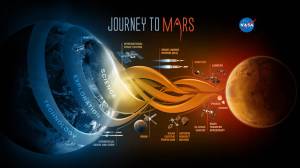NASA has successfully tested their first RS-25 rocket engine for the agency’s next heavy lift rocket, the Space Launch System (SLS), for 500 seconds. The SLS, which will use 4 RS-25 engines in its core stage, is designed to take humans to deep space destinations like asteroids or Mars.
NASA stated that “the next time rocket engine No. 2059 fires for that length of time, it will be carrying humans on their first deep-space mission in more than 45 years.”
Interestingly, the engine used in the test was one that flew during the Space Shuttle Program. After the space shuttle retired, there were 16 RS-25 engines (also known as the space shuttle main engine) left over.
Aerojet Rocketdyne, the prime contractor for the RS-25 engine, has modified the engine to meet the performance requirements for the SLS. These modifications will enable the engine to operate at 109 percent thrust levels, up from the 104 percent thrust level generally used for the space shuttle.
Four RS-25 rocket engines will be joined with a pair of solid rocket boosters to create the configuration for the first SLS flights.

Because RS-25 engines were used in 135 space shuttle missions between 1981 and 2001, Aerojet Rocketdyne calls them “the world’s most reliable rocket booster engine.”
During the space shuttle program, the RS-25 engines would return to Earth on space shuttle orbiters to be refurbished and reused. With the SLS, the engines won’t be coming back.
Because the rocket engines will be expendable, the 16 RS-25 engines in inventory will allow for 4 flights with SLS. In November of last year, a $1.16 billion contract was awarded to Aerojet Rocketdyne to restart the development of the RS-25 engine. The contract stipulated that NASA could order 6 additional RS-25 engines, allowing for a fifth SLS flight.
Engine testing will continue to be conducted at NASA Stennis Space Center in Mississippi, while the SLS program is managed by NASA’s Marshall Space Flight Center in Alabama. Ultimately, the SLS will use ground operations and launch facilities at Kennedy Space Center in Florida.
This week’s test was used to validate the updated engine’s capabilities and verify the different operating conditions needed for the SLS.
“Not only does this test mark an important step towards proving our existing design for SLS’s first flight, but it’s also a great feeling that this engine that has carried so many astronauts into space before is being prepared to take astronauts to space once again on SLS’s first crewed flight.” – Steve Wofford, engines manager at NASA’s Marshall Space Flight Center
SLS will carry the Orion capsule with up to 6 crew members on board to deep space destinations laid out in NASA’s Journey to Mars initiative. Although some are skeptical that this will ever happen citing insufficient funding levels and an unclear mission manifest for the program. Critics call the SLS the “Rocket to Nowhere.”

There are many factors that will determine the fate of the SLS program, including the upcoming Presidential election and change of administration, but time will tell if NASA’s next powerhouse rocket can be sustainable.
SLS, complete with 4 RS-25 engines, is scheduled to make its first flight in 2018 with an uncrewed Orion along with 13 CubeSats onboard.
Correction: Article originally stated that this was the first test fire of the SLS engine. This was actually the first flight certification test of the SLS engine, which had been test fired previously.































Comment